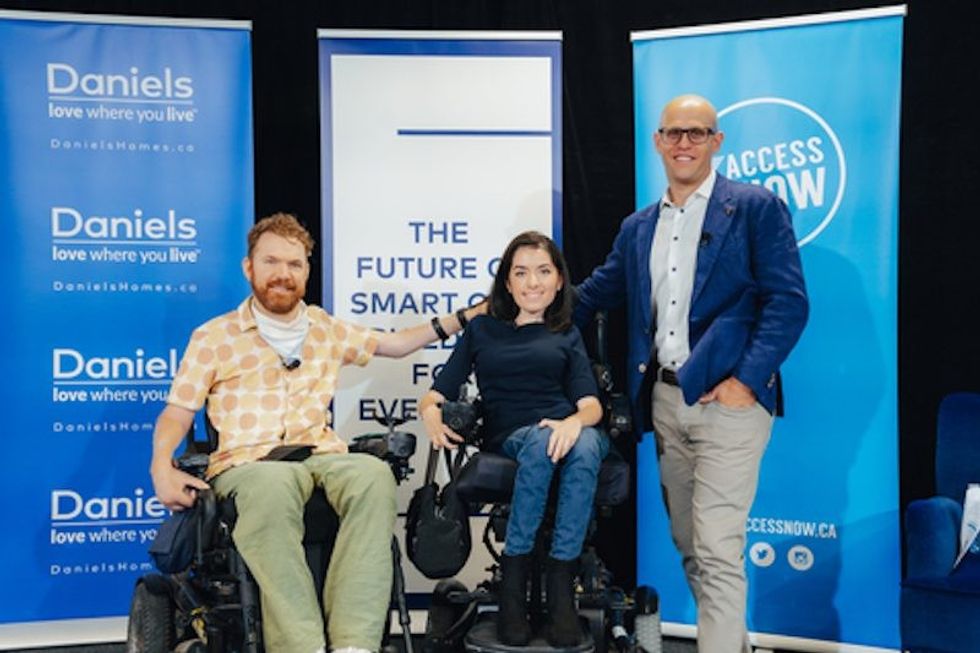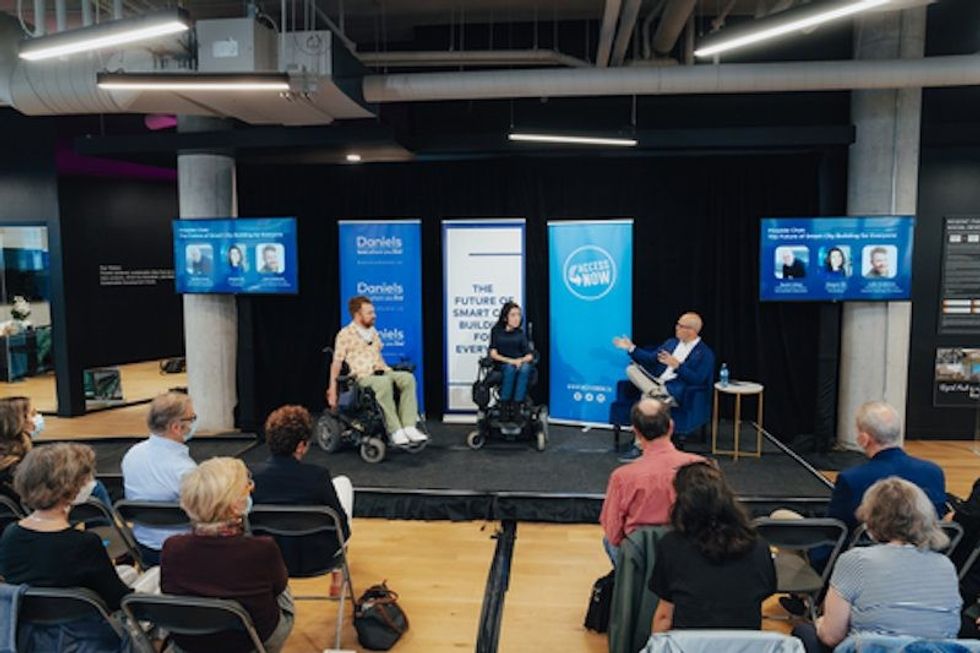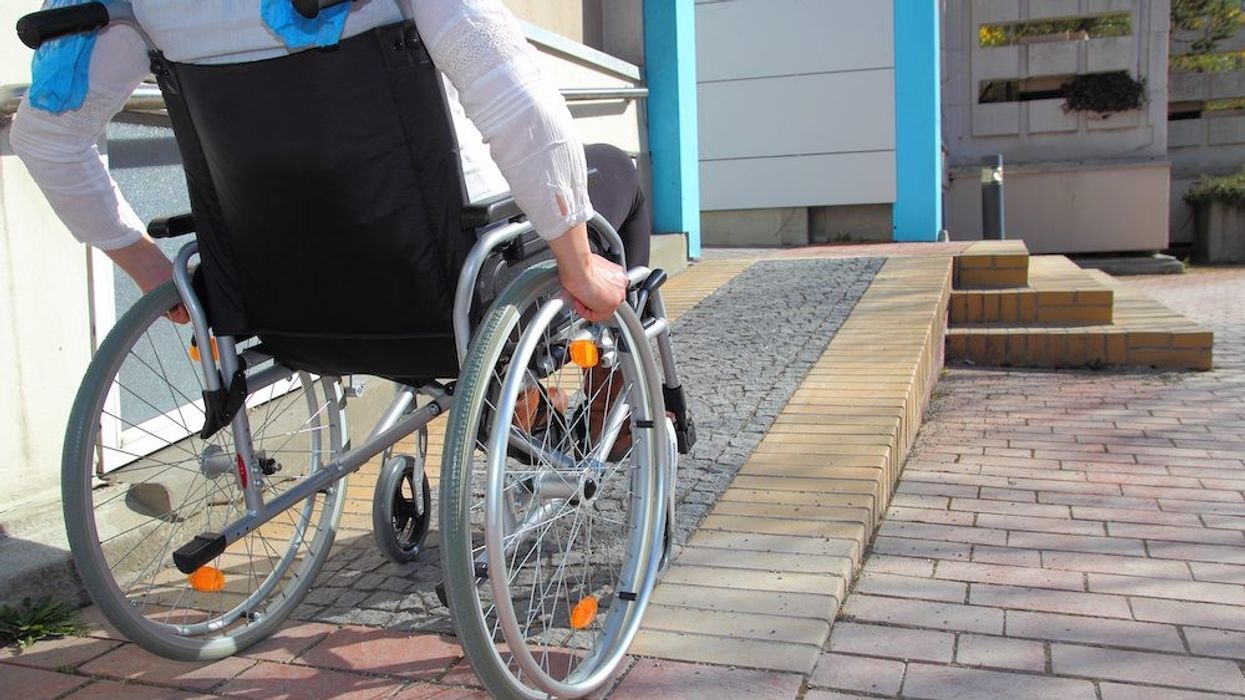“I don’t want hospital gear, I want things that look like jewellery,” said Maayan Ziv last week at an event held at the World Urban Pavilion in Regent Park.
The celebrated Toronto-based entrepreneur and activist, who lives with muscular dystrophy, had this candid thought when recently introduced to a new accessibility product.
“When we talk about accessible design, the level of aspiration that I really want to see is a move away from this,” she continued. “There’s phases; you have to understand the needs of people and focus first on function. But once we understand function, how can we make it feel good? How do we get to the point where it’s not a reminder that you have a need that’s different than someone else, and it just melts into the environment; it doesn’t stick out like something you may see in a hospital?”
The sad reality, however, is that many spaces throughout Toronto lack even what Ziv calls the “clunky and awkward” accessibility features in the first place. And when 24% of Ontario’s population is currently living with some sort of a disability, it remains a head-scratcher why widespread inclusion and accessibility hasn’t made its way into the housing market -- and everyday life for that matter.
Ziv was at the World Urban Pavilion to announce a partnership between Toronto-based builder and developer The Daniels Corporation (Daniels) and AccessNow, a tech company Ziv founded that seeks to make communities easier to navigate for people with disabilities.

Since 2016, the AccessNow app has been the go-to information resource for people living with disabilities. Spanning over 35 countries worldwide, AccessNow’s platform is built for the community, by the community, and provides a pan-disability lens on the accessibility of physical spaces.
The partnership with Daniels aims to map, review, and rank the accessibility of businesses and public spaces in Regent Park -- a once dismal and uninspiring neighbourhood that was revitalized in the past ten or so years to better serve the local community. In 2005, The Daniels Corporation partnered with Toronto Community Housing to re-develop 53 of the 69 acres of Toronto’s Regent Park. Results from the reviewing and mapping process will highlight both the successes and barriers that currently exist for people living with disabilities in how they live, work, and play within the community.
These “MapMissions” are front and centre to building out and informing the AccessNow mobile app and web platform, which allows people to search for places in their community that are accessible, based on their location and needs. On May 25, 2022, the AccessNow team, Daniels and local Regent Park residents came together for a MapMission event to explore the accessibility of places in the neighbourhood.
Results from the MapMission revealed two-thirds (66%) of places in Regent Park were rated accessible by residents. A total of 500 accessibility features were observed throughout the community, including automatic doors, accessible parking spots and elevators, digital menus, braille, lowered counters, and gender-neutral washrooms, among other things.
“What was great to see was the overall accessibility cohesion across the neighborhood in Regent Park,” says Ziv. “The majority of spaces we visited had automatic doors and an average of 66% of businesses were rated accessible by residents who mapped with us in May.”
In particular, the Daniels buildings have made a conscious effort to thoughtfully incorporate accessibility needs. “At Daniels’ newly built Evolv Rental Residences in Regent Park, we truly have implemented best and inclusive practices within our design at that residence, both in the common areas of the building and within the Accessibility Designed Suites,” says Jake Cohen, Chief Operating Officer, The Daniels Corporation. “For instance, best design practices such a lowered concierge desks, touchless automatic door openers, automatic waste chutes, brail signage, and the creation of amenity spaces that take into consideration accessibility such as party rooms, fitness spaces, outdoor gardening plots, and kids’ rooms to name a few.”
Daniels Accessibility Designed suites are included throughout the building and are designed and constructed beyond the accessibility standards of the Ontario Building Code and offer features such as roll-in showers, roll-out balconies, larger turning radii, and modified kitchens, says Cohen. Daniels continues to create more accessible buildings and communities through their Accessibility Designed Program (ADP), which focuses on improving design standards and ensuring universal accessibility.

While many parts of Regent Park may shine in the accessibility department, not all Toronto neighbourhoods are created equal by any stretch. "We know for certain there are neighbourhoods that are more accessible than others in Toronto,” says Ziv. “For example, we know much of Yorkville or Queen West can be very inaccessible, whereas downtown Yonge or Regent Park are currently showing up as much more ‘green’ or ‘accessible’ on our map. But we are just scratching the surface on the types of insights we can discover to determine what about specific neighborhoods is or is not accessible to folks. Regent Park, with its new development led by Daniels, is a beautiful example that showcases what is possible.”
Cohen says one of the most prominent examples of inaccessible spaces that he sees are those that are built to be accessible, but -- sadly -- businesses are not operationally using them in accessible ways. “For example, the other day I was in a café and noticed that they had boxes of inventory lined up down the hallway and in the accessible washroom,” says Cohen. “Businesses need to look at their spaces through an inclusive lens and not create barriers.”
More than a nice idea, designing with accessibility and inclusivity top of mind should be standard across all new builds -- from homes to office spaces.
“The larger residential buildings are getter better,” says Luke Anderson co-founder and executive director of StopGap Foundation, who joined Ziv and Cohen in a fireside chat at the event. The StopGap foundation is a registered charity that is helping create a world where every person can access every space.
“But we’re still stuck in part 9 of the building code," continued Anderson. "The lower-rise wood-frame townhomes that are still going up in a big way are not accessible. We are seeing walk-ups to split-level townhomes that are not accessible. And that’s a huge problem. I see this as a poor use of human resource. Going an hour out of the city to suburbia, it’s also such a poor use of human resource a lot of those buildings aren’t usable for people who use mobility. That’s a big concern.”
With our aging population, a lack of accessible housing will become an even bigger concern. “I would like to see all builders across the GTA approach homebuilding through the lens of inclusivity to ensure the communities they create, and build are not only accessible, but also resilient, and foster a sense of belonging for everyone,” says Cohen.
And the time to act is now.
“Collectively, as an industry, we need to understand any current or future barriers for those living with disabilities and work together towards solutions,” continued Cohen. “There is an incredible network of organizations and individuals across the GTA who focus on accessibility such as our friends at AccessNow and StopGap Foundation that are eager to share invaluable insights to help us create communities that are accessible for all and allow individuals of all abilities to thrive where they live, work, and play.”
In the meantime, Ziv will continue to make major moves through her activism and the growth of AccessNow. “At AccessNow, we are mapping every space across the city, and around the world, in order to uncover accessibility features wherever they are and connect people with better information about the places where we live, work, learn, and play,” says Ziv. “We know we can use this data, and the insights co-created and driven by people with disabilities, to inform the future of city building. We are excited to continue developing partnerships with organizations and municipalities that lead to more accessible and inclusive communities for people with disabilities. And it all starts with information sharing.”
For Ziv, inclusion really comes down to is a sense of belonging.
“It’s the ability to show up with no questions asked and be included,” she says. “It doesn’t ask you, ‘what’s your problem?’ or ‘what you need?’ It just welcomes you in. That could be a space or it could be a product that doesn’t ask any questions but just works. That’s the universal experience; it’s designed to include you in default. So, you come to a space and the doors just open and you’re not asked to go through the garbage entrance. Or not told to apologize for who you are. Those are all the side effects of not designing for inclusion.”





















